Extensive heat treatment and microstructure evaluations were conducted on CM 939 Weldable alloy to evaluate alternative thermal processing. Two heat treatment options emerged as commercially desirable: a five-step production cycle which combines a typical industry multi-stage heat treatment cycle [9] with a coating diffusion cycle, and a simple three step thermal cycle [10] (which also incorporates the coating diffusion step).
Typical microstructures of CM 939 Weldable alloy as-cast and after thermal treatment are shown in Figures 3-4, respectively. Note that minimal eta (h) phase is present in the as-cast microstructure, and there is no eta phase in the heat-treated microstructures. Eta phase, Ni3(Ti,Cb,Ta), is an undesirable, brittle phase often found in high Ti,Cr,Ta- containing alloys and related to low ductility [11]. High magnification SEM photo micrographs of grain boundary carbide microstructures following heat treatment show fine discrete carbides, which are key to obtaining good alloy strength and ductility (Figure 5) [12].
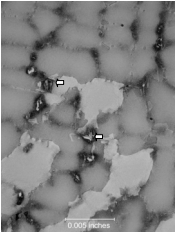 Figure 3 - As-cast CM 939Weldable showing minimaleta phase (arrows)
Figure 3 - As-cast CM 939Weldable showing minimaleta phase (arrows)
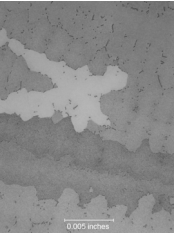 Figure 4 – Microstructure ofCM 939 Weldable followingheat treatment
Figure 4 – Microstructure ofCM 939 Weldable followingheat treatment
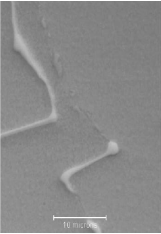 Figure 5 – Fine, discretegrain boundary carbides inCM 939 Weldable after heattreatment
Figure 5 – Fine, discretegrain boundary carbides inCM 939 Weldable after heattreatment
Typical tensile properties for CM 939 Weldable alloy are shown in Table 2; typical stress-rupture properties are presented in Table 3 and Figure 6. Comparative properties for standard IN 939 [13] and GTD 222 [14] alloys are included where available. GTD 222 alloy (Table 1 [15]) is an alternate alloy developed by General Electric Company and often used in similar applications to IN 939 alloy. GTD 222 has improved ductility, but lower strength compared to standard IN 939 alloy.
Analysis of the comparative data shows that CM 939 Weldable has similar strength to IN 939 alloy, with improved ductility and significantly improved strength compared to GTD 222 while maintaining good ductility. In other words, CM 939 Weldable provides the best combination of strength and ductility of the three alloys.
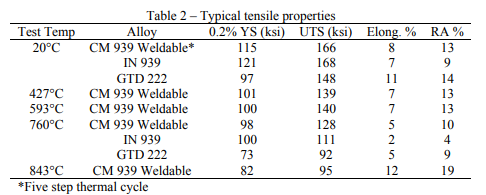
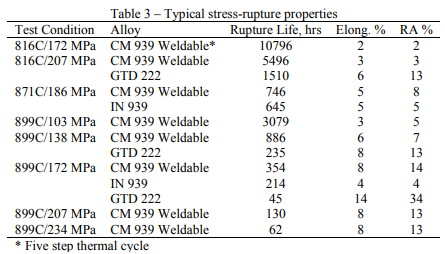
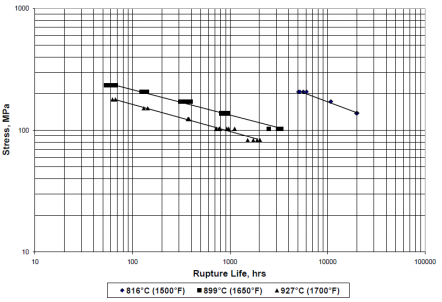
Figure 6 – CM 939 Weldable stress-rupture life (five step thermal treatment)
As an alternative, the three step thermal cycle is shorter, less complex and therefore less expensive post-cast processing. The mechanical property data for this option shows improved strength compared to the five step cycle, with slightly reduced, but still acceptable, ductility. In addition to the overall improvement in rupture life, a significant increase in time to 1% creep has been observed with this thermal treatment [16].
The improved ductility and weldability of CM 939 Weldable alloy has been evaluated through a series of trials conducted by TWI Ltd. (Cambridge UK) under a number of pre-weld thermal conditions, including as-cast, overaged and as-heat treated. Good welding practices include a post-cast annealing or overaging procedure prior to welding; alternate conditions were included to correlate the alloy ductility to the occurrence (or non-occurrence) of weld microcracking. Bead on plate welding trials using both Alloy 625, C263 and Haynes 282® alloy filler wire demonstrated no evidence of HAZ cracking in both the aswelded and post weld heat treated condition [17,18]. Typical microstructure is shown in Figure 7. This work along with routine repair welding of cast components at multiple casters (with no indication of cracking problems) confirmed the improved weldability of CM 939 Weldable alloy. Recent development for improved strength capability has resulted in successful production of CM 939 Weldable filler wire, which is commercially available from Polymet Corporation (Cincinnati, OH) and in use for weld repair of CM 939 Weldable castings.
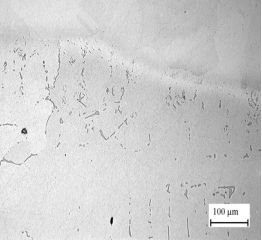 Figure 7 – Typical weld microstructure at the CM 939 Weldable/C263 filler metal fusion line
Figure 7 – Typical weld microstructure at the CM 939 Weldable/C263 filler metal fusion line
As a result of the favorable property evaluations, CM 939 Weldable is replacing IN 738 LC and IN 713 LC alloys for structural components such as combustor and turbine casings and vane rings in small high performance turbojet applications.
CM 247 LC Alloy
Early DS castings were made from equiax blade alloys such as MAR M 002, MAR M 200 and MAR M 247; however, many of these alloys exhibited low ductility and cracking along the DS grain boundaries [19]. This provided the impetus for development of alloys optimized to take advantage of the DS process. CM 247 LC alloy (Table 4) is a modification of MAR M 247 alloy designed to reduce DS grain boundary cracking of thin-walled complex cored castings.

Chemistry modifications for CM 247 LC alloy included reducing Zr and Ti content and tighter control of Si and S which produced improved castability. Reduced C content improved the carbide microstructure, carbide stability and room temperature to intermediate temperature ductility. CM 247 LC alloy shows a 2x improvement in ductility compared to standard MAR M 247 alloy. W, Mo and Cr content were reduced to compensate for lower C to balance the alloy for Phacomp considerations [19]. These changes were also beneficial to equiax castings, resulting in less hot tearing & hot cracking; consequently, CM 247 LC alloy has also been selected for many EQ applications, such as axial and centrifugal integral wheels, turbine blades and vane segments.
Re-bearing Alloys
The next significant advance in alloy development was the introduction of rhenium (Re) to EQ, DS and SX alloys (Table 5). These so-called “second generation” alloys possess significant improvement in creep-rupture properties due to Re which partitions to the γ matrix, retards coarsening of the γ’ (strengthening) phase and increases the gγ/γ’ misfit [20]. Re “clusters” act as obstacles to dislocation movement resulting in improved alloy strength.


